Why do baby slings and carriers seem to be magic at calming many upset babies and able to reduce crying? Why do they often seem to be full of "sleepy dust"?
I’ve heard so many parents say to me “why didn’t I think of the sling sooner?” after an episode of seemingly inconsolable crying, that finally stopped when baby was cuddled up snugly and safely into a sling/carrier. Slings seem to help so many families to feel calmer and reduce crying.
The famous (if flawed) 1986 Hunziker and Barr study (1) showed that young infants who experienced “supplemental carrying cried and fussed 43% less overall.” The Esposito study (2) showed “Infants under 6 months of age carried by a walking mother immediately stopped voluntary movement and crying and exhibited a rapid heart rate decrease, compared with holding by a sitting mother.”
Why is this? What is it about carrying that calms babies so well and reduces their crying?
Well, there are lots of reasons for this, the most important being how it makes babies feel.
To understand the “power” of a good, comfortable sling/carrier, it will help to think about how a young baby experiences the world. Birth brings a huge change from the environment of the womb; however a baby is born, it is life-changing and very likely an uncomfortable process.
Let’s look at some of the differences between life inside and life outside.

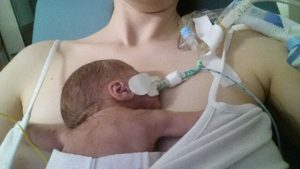
Babies feel reassured and safe when they are close to people they recognise and trust. Their sense of smell is one of the better developed senses at birth and babies can recognise their mother’s personal scent from its similarity to the amniotic fluid.
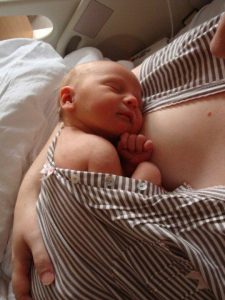
The sensation of gentle motion of in arms holding and rocking (which we all instinctively do with babies) affects heart and brain function, and is very calming (Esposito, 2013, 2). Soft touch has been found to reduce the experience of pain and research is underway at Oxford University as stroking seems to reduce heel prick pain. Many babywearing parents will have found their child less distressed by injections if they are in the sling (or being fed!)
Loving warm arms keeping a baby gently contained will also feel very familiar.
Beyond this simple skin to skin and holding, a soft yet supportive sling/carrier will remind baby even more of the home they have left behind.
So how do slings help more than just holding when a baby can’t settle or be comforted from their crying?
This assumes of course, that baby isn’t hungry, thirsty, hot or cold, in pain or many of the other reasons they may be in distress. Slings can help with the pain of reflux of course, and there are many reasons why slings are good for babies and their carers, but assuming your baby doesn’t seem to have an obvious problem, and just not able to settle, a sling will often help.
Babies will often settle into slings when parents feel confident with their use; this is where practising when baby is in a good mood or with your local sling library can be so helpful. Uncomfortable slings will not help an already upset baby, and if you feel uncertain, baby may pick up on your extra tension. Read more about crying in slings here.
- Soft, strong, mouldable baby carriers have the same basic effect as in arms holding, but are more consistent and reliable. Parents shift babies around their bodies frequently as their muscles feel the strain of the unexpected weight, and they put their babies down quickly. In contrast, being held on the chest in a comfy sling/carrier will hold baby in a more comprehensive way that provides a greater surface area of support. The slight give that many fabric based slings have will mimic the feel of uterine walls, allowing movement but still a clear boundary.
- A child held safely in a sling is supported evenly, with no especial pressure points or sudden liftings or movements, which will increase their feeling of safety and security.
- This will also have the effect of reducing overall sensory input. Babies have a huge amount of information bombarding them without (yet) the skills to focus attention and ignore extraneous inputs. In the same way, a weighted sensory blanket can help children with sensory processing difficulties to feel calmer and less overwhelmed.
- Parents/carers are able to sway with baby in the carrier, and do something else as well; which can be very helpful if everyone is tense. Being able to go for a walk, or make a cup of tea, and feel your baby beginning to relax, will help tense, tired muscles to loosen, and shaky breathing to slow and regulate. Oxytocin and the parasympathetic system are now work in baby and carer, calming everyone’s heart rate, reducing the amount of cortisol in the system and bringing the fight-or-flight stress response of the sympathetic system under control.
- Parents often find the feeling of being wrapped up with their baby beginning to sink into trustful sleep on them extremely therapeutic, and some find woven wraps can actually provide a feeling of being held-together, or massaged. Babies seem to experience this too; many families comment that they watch their babies falling asleep during the process of wrapping, as the fabric tightens across babies’ backs, they visibly relax. It feels familiar, it feels good, it feels safe, all feels right again! There is also the enormous benefit that the rhythmic rocking and shushing and swaying with a baby securely supported in a safe carrier can have for an anxious parent: slings can calm parents down too.
- Being wrapped up in a baby carrier can also create warmth; warmth often helps to alleviate discomfort and aid sleep. It is very important, however, that babies do not overheat; the combination of the parent/carer’s body heat and the layers of clothes and carrier can be too much, especially if parent is hot and bothered, or if the baby is taken for a brisk walk (which raises core temperature). Hot babies are at risk of reduced breathing; please check your sleeping baby often and if you are sweating or baby feels hot, consider removing them from the carrier and removing some layers.
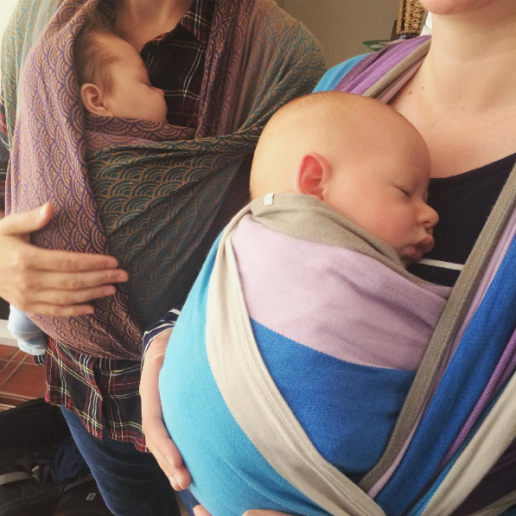
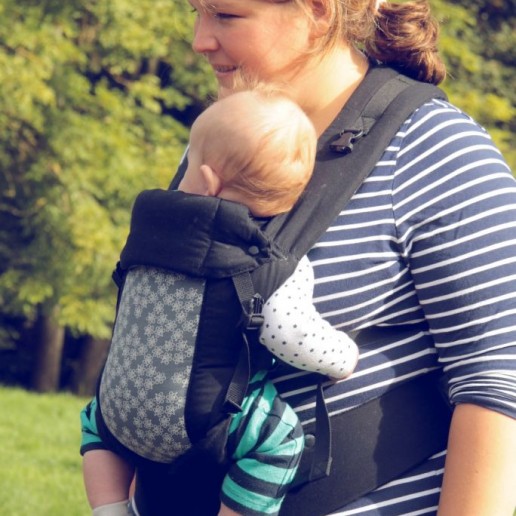
 What do I need to know about keeping my baby safe in my sling now they have settled down?
What do I need to know about keeping my baby safe in my sling now they have settled down?
The main things to remember are that baby’s airway needs to be clear and unobstructed by flesh or fabric. Their heads should be free to move if needed and not pressed forwards so their chin sinks onto their chest. They should be comfortably held chest to chest, which keeps ribcage and back well supported, and in a supported seated squat (the M and J shapes). Read more about baby safety here.
They should not be too warm, and should be checked often for comfort, and position adjusted slightly to ensure no pressure points develop.
Don’t forget some self-care; looking after distressed babies is hard work. Just don’t fall asleep yourself while your baby is in the sling!
If your baby loves to sleep in the sling, don’t panic. Good quality sleep is very valuable for the newborn growing brain and as everyone gets more familiar with family life this will get easier. Babies sleep where they feel safe, and with time babies can be transferred from the sling (very slowly, in small stages, avoiding sudden changes to warmth/position etc) to safe sleeping places. They will learn to sleep on other trusted carers and in other trusted spaces that smell and sound familiar.
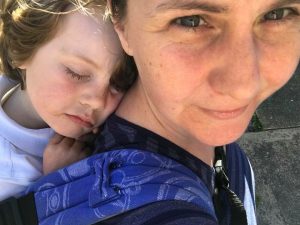

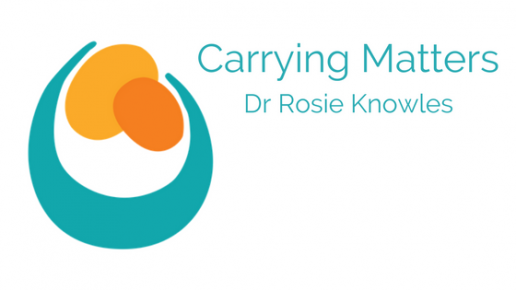
 What do I need to know about keeping my baby safe in my sling now they have settled down?
What do I need to know about keeping my baby safe in my sling now they have settled down?